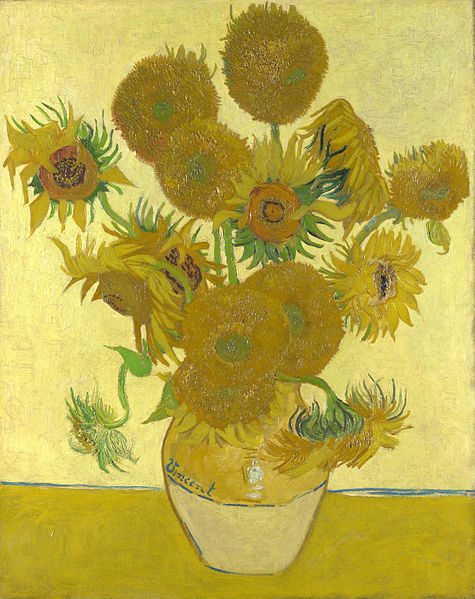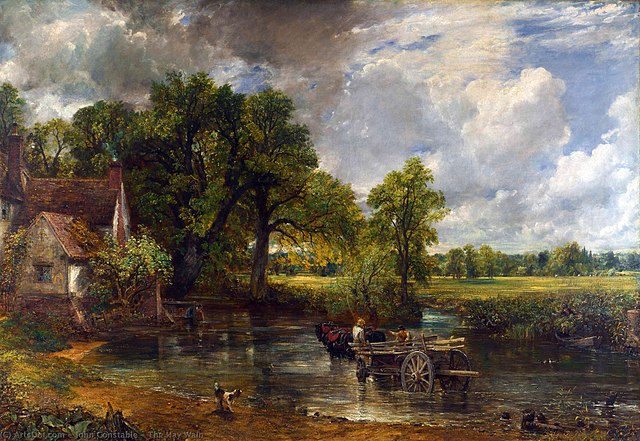With it’s wealth of history and museums is it any wonder that you can find some of the greatest works of art in London.
With massive galleries such as the National Gallery and the Tate Modern any art enthusiast will be spoiled for the sheer volume of great paintings on display.
Below are some of the most famous paintings in London by some of the great masters.
Famous London Paintings
1. The Fighting Temeraire – J. M. W. Turner

The Fighting Temeraire, dragged to her last berth to be broken up is the full title of Turner’s 1838 oil painting, which was shown at the Royal Academy the following year.
In this 1838 photograph, one of the last second-rate ships of the line to participate in the Battle of Trafalgar, the 98-gun HMS Temeraire, is being towed up the Thames by a paddle-wheel steam tug before being broken up for scrap.
Turner bequeathed the picture to the nation in 1851. The National Gallery in London is now exhibiting it. It was deemed the best artwork in the country, and so it was used on the new £20 bill.
Also Read: Famous Statues in London
When Turner created this, he was at the pinnacle of his profession. His exhibitions at London’s Royal Academy spanned 40 years.
His dark, brooding paintings explored the effects of the elements and light.
He devoted much of his life to living and working on and around the River Thames, and the resulting paintings of ships and waterfront settings are many and acclaimed.
When planning his paintings, Turner frequently resorted to quick sketches that he would later develop into more detailed drawings in his studio.
2. Arnolfini Portrait – Jan van Eyck

One of the most well-known portraits of a married couple, The Arnolfini Portrait by Jan van Eyck, was created in 1434 as an oil painting on a hardwood panel.
Even in the smallest of details, the picture is well-known for its exceptional clarity and sharpness. The couple depicted in the artwork are said to be affluent Italian merchants, and the home seen in the background is their extravagant mansion.
A religious look spreads across his face as he holds the hand of his pregnant wife. Van Eyck expertly layered the painting’s hues and tones, which caused the viewer to be drawn deeper into the work.
The artist has rendered the coupling with such lifelike detail that it seems to continue into infinity and beyond.
3. Bacchus and Ariadne – Titian

For Alfonso I d’Este, Duke of Ferrara’s Camerino d’Alabastro, a private chamber in his Ferrara palace, Titian painted a series of mythological scenes, including Bacchus and Ariadne (1522–1523).
The contract for a Triumph of Bacchus had originally been given to Raphael, and he was granted a lump sum payment to begin work immediately.
Since Raphael had only completed a rough draft before his death in 1520, the commission went to Titian. Bacchus and Ariadne’s themes come from the works of Roman poets Catullus and poet Ovid.
Theseus had left his love, Ariadne, on the island of Naxos, and sailed away in his ship, which is seen out to the far left. The god of wine, Bacchus, finds her on the shore while conducting a party in a chariot drawn by two cheetahs.
Bacchus is shown launching himself out of the chariot to protect Ariadne from the monsters.
The National Gallery in London is now showing the painting, which is widely considered to be one of Titian’s finest works.
4. Vase with Fifteen Sunflowers – Vincent van Gogh

Vincent Van Gogh’s depictions of flowers are unlike any others in art history.
Despite his many mental disorders, he had an uncanny ability to portray the innocence and purity of a flower’s innate beauty in a way that no other artist has been able to match.
Apparently Van Gogh was mesmerized by sunflowers and how they changed in brightness as the sun moved across the sky.
Van Gogh’s Sunflowers, for example, is part of a larger series exploring the nuances of the sunflower.
Van Gogh’s vibrant paintings of sunflowers bring the plants to life and bring out the subtleties of their stalks and leaves. His paintings of Aries, a French town, date around 1889. A vase with a bunch of sunflowers was the subject of each piece of art.
It is thought that he painted several pieces in the series while he was a resident of the Yellow House and Paul Gauguin was a guest there.
Gauguin called Sunflowers “completely Vincent,” noting that the artist’s lighting gave viewers a new perspective on the kaleidoscope of hues contained within each petal.
5. Rokeby Venus – Diego Velázquez

Diego Velázquez, the preeminent artist of the Spanish Golden Age, is credited for creating the famous Rokeby Venus.
It was painted between 1647 and 1651, during the artist’s trip to Italy, and represents Venus in a sexually suggestive stance, laying on a bed and gazing into a mirror held by her Roman son Cupid. The picture can be seen in London at the National Gallery.
There are no other female naked paintings by Velázquez that have survived to the present day except for the Rokeby Venus. In the seventeenth century, when the Spanish Inquisition was vigorously policing artwork, nude depictions were highly unusual.
Despite this, courtiers avidly collected nudes by foreign artists, and this one displayed in their homes until 1813, when it was shipped to Rokeby Park in Yorkshire, England.
The National Art Collections Fund acquired the artwork for the National Gallery in London in 1906. The suffragette Mary Richardson assaulted it and severely damaged it in 1914, but it was quickly fixed and put back on display.
6. Virgin of the Rocks – Leonardo da Vinci

The Virgin of the Rocks was the subject of not one, but two versions by Da Vinci. The aforementioned version 1 is currently shown in the Louvre and is considered the “prime version” (the first or earliest).
A second copy, called the London Virgin of the Rocks, can be seen in the collection of the National Gallery in that city.
In 1806, French restorer Fr. Hacquin transferred the oil on wood panel version of the Louvre painting on canvas.
Two more paintings by Leonardo’s collaborators are also connected to the project; they depict angels with musical instruments. The National Gallery in London features both.
They have the common theme of depicting the Madonna and Child, along with the infant Jesus, John the Baptist, and an angel, against a rocky landscape, hence the common name. Aside than those two tweaks, the ingredients are interchangeable.
There have been major structural changes to the angel’s right hand and right eye. Color, lighting, foliage, and Leonardo’s use of sfumato are just a few of the subtle differences between the Louvre and the National Gallery versions.
7. Supper at Emmaus – Caravaggio

Painting completed by Italian Baroque painter Caravaggio in 1601 and currently housed in the National Gallery, London.
The Supper at Emmaus depicts the disciples’ meal together after Jesus’ resurrection. It was originally commissioned and financed for by Ciriaco Mattei, brother of cardinal Girolamo Mattei.
In the town of Emmaus, two of Jesus’ followers (likely Luke and Cleopas) encounter the masked risen Jesus, who then disappears from their sight (Gospel of Luke 24: 30–31).
The painting is unique because to its life-size characters and its black, empty background. The still life features a table with a basket of food precariously perched on the edge.
In 1606, Caravaggio created a second rendition of the Supper at Emmaus, which is currently housed in the Brera in Milan. Figures, on the other hand, use far smaller, more restrained motions, emphasizing presence over performance.
Both adaptations employ the Trompe-l’oeil painting style, which gives the illusion of movement through the characters’ poses and gestures to draw the viewer in.
This difference could be attributed to Caravaggio’s personal situation at the time (he had fled Rome as an outlaw after Ranuccio Tomassoni’s death) or to the fact that he had grown to appreciate the significance of understatement in his art over the course of the ensuing five years.
8. The Ambassadors – Hans Holbein the Younger

The Ambassadors was painted by Hans Holbein the Younger in 1533. The Tudor period’s Jean de Dinteville, also known as Georges de Selve, was conceived in the same year that Elizabeth I was born.
Anne Boleyn, Queen of England at the time, may have commissioned the painting as a present for the envoy pictured on the left, Jean de Dinteville, according to Elizabeth’s biographer, Franny Moyle.
In addition to the two figures, there is a still life with a variety of artifacts that have been the subject of heated discussion over their significance. There’s a famous anamorphic artwork included. Since 1890, when it was purchased, The Ambassadors has been hanging in London’s National Gallery.
The most well-known and easily identifiable symbol in Holbein’s composition is the twisted skull in the composition’s lower center.
The skull, rendered in anamorphic perspective, is meant to present the spectator with a perceptual challenge because it is only when viewed from above, on the right, or below, on the left, that the viewer is able to identify the shape as that of a human skull.
The skull is a definite vanitas or memento mori, although it is not apparent why Holbein gave it such a prominent position in the picture.
9. Ophelia – John Everett Millais

Sir John Everett Millais’s Ophelia, painted between 1851 and 1852, is currently on exhibit in London’s Tate Britain. During her death scene in Hamlet, Ophelia sings a song as she floats down a Danish river.
Because of its beauty, precision, and impact on painters like John William Waterhouse, Salvador Dal, Peter Blake, and Ed Russa, it has been heralded as one of the most significant works of the mid-nineteenth century.
Ophelia is depicted in the painting singing as she glides peacefully down the river. You might picture the scene from Queen Gertrude’s monologue in Hamlet’s Act IV, Scene 7.
In it, a woman who spends her entire life longing for happiness finally accepts her fate at the end. Pre-Raphaelite art is rife with depictions of vulnerable women.
Millais’s dedication to realism, skill at capturing natural light, and use of vibrant color earned him widespread acclaim.
10. The Hay Wain – John Constable

The 19th-century British artist John Constable is largely regarded as one of the greatest landscape paintings in history.
Born in England in 1776, Constable became widely recognized as a leading Romanticist painter of his day. Oftentimes, he would paint scenes that included trees and vast, European vistas.
In 1821, Constable completed what would become one of his most recognizable works, The Hay Wain. The farmer in the artwork is making his way over the rural borderlands between Suffolk and Essex in his horse-drawn wagon.
Beside painting expansive trees by the river, Constable captured the serenity of life for English farmers.

